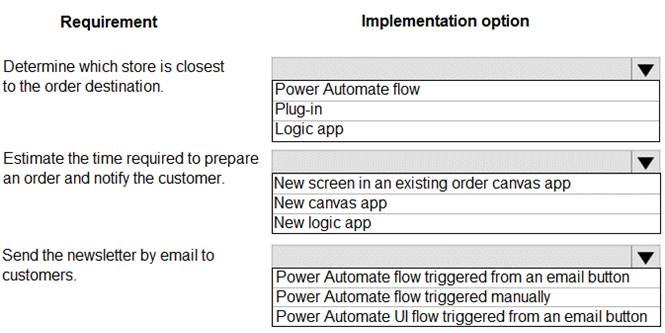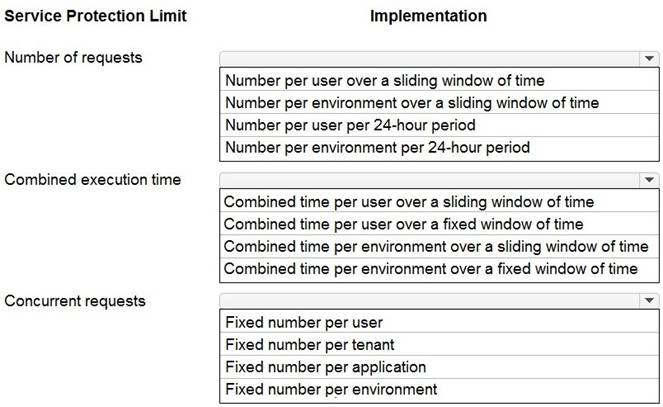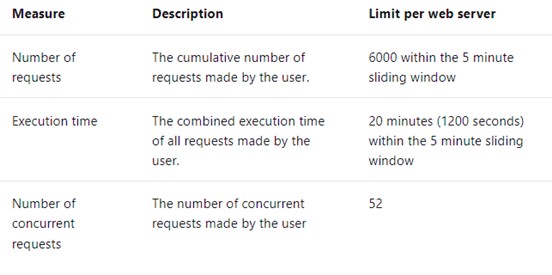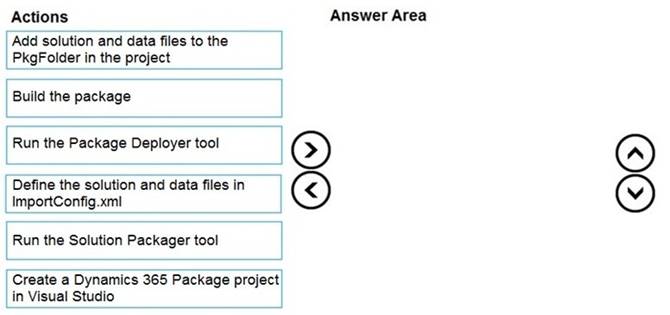HOTSPOT - (Topic 6)
You create a suite of Power Platform-based order management canvas apps for a bakery that has five retail stores. Each store uses a tablet device to manage inventory and process orders.
You need to make the following changes to the original order tracking app:
✑ When an online order for delivery is received, send the order to the bakery that is
located closest to the order destination.
✑ When an online order for pickup is received, require store staff to enter an estimated time in an app. Staff must prepare the order and then use the app to notify the customer when the order is ready.
✑ Allow the store manager to personalize the company’s corporate weekly newsletter and add store-specific specials.
You must minimize the amount of custom code and configuration required to implement the solution.
What should you use? To answer, select the appropriate options in the answer area.
NOTE: Each correct selection is worth one point.
Solution:
Box 1: Custom self-service portal for both employers and job candidates
If you select an environment that contains customer engagement, you can create the following portals:
Customer self-service portal: A customer self-service portal enables customers to access self-service knowledge, support resources, view the progress of their cases, and provide feedback.
Partner portal: A partner portal allows every organization with resellers, distributors, suppliers, or partners to have real-time access to every stage of shared activities. Employee self-service portal: An employee self-service portal creates an efficient and well- informed workforce by streamlining common tasks and empowering every employee with a definitive source of knowledge.
Box 2: Model-driven app with push notifications
Compared to canvas apps, model-driven apps in PowerApps are based on underlying data
— specifically, the data stored in Common Data Service (CDS). Box 3: Webform with target set to the job custom entity
Box 4: Configure a value for the Execute Workflow on Redeeming Contact option only.
Execute Workflow on Redeeming Contact: A workflow process to be executed when the invite is redeemed. The workflow will be passed the redeeming contact as the primary entity.
Box 5: Configure the value for the Assigned to Account option only.
Assign to Account: An account record to be associated as the redeeming contact's parent customer when the invite is redeemed.
Does this meet the goal?
Correct Answer:
A
HOTSPOT - (Topic 6)
You are designing an integration between Dataverse and an external application. The external application processes thousands of records per day.
Record processing volumes vary throughout the day. Extremely high processing volumes may occur and may exceed the Dataverse service protection API limits.
You need to implement each service protection limit that is enforced.
Which implementations should you use? To answer, select the appropriate options in the answer area.
NOTE: Each correct selection is worth one point.
Solution:
Box 1: Number per user over a sliding window of time
Service protection API limits are enforced based on three facets:
✑ The number of requests sent by a user.
✑ The combined execution time required to process requests sent by a user.
✑ The number of concurrent requests sent by a user.
The following table describes the default service protection API limits enforced per web server:
Box 2: Combined time per user over a sliding window of time Box 3: Fixed number per user
Does this meet the goal?
Correct Answer:
A
- (Topic 6)
You are troubleshooting a new canvas app.
Users report the app loads slowly. You use the Monitor tool to view various events being performed in the app. Events performed in the app do not have formula details.
You need to enable formulas to be included with the Monitor tool events. What should you do?
Correct Answer:
A
DRAG DROP - (Topic 6)
A company has Common Data Service (CDS) environments for development, test, and production.
You have a model-driven app that consists of two solutions. The solutions include settings and reference data. You plan to move the solutions, app settings, and reference data from a development environment to a production environment.
You export each solution from the development environment as a zip file.
You run the Configuration Manager to export the settings and reference data as zip files. You need to prepare the app and its settings for deployment.
Which four actions should you perform in sequence? To answer, move the appropriate actions from the list of actions to the answer area and arrange them in the correct order.
NOTE: More than one order of answer choices is correct. You will receive credit for any of the correct orders you select.
Solution:
Step 1: Add your files to the project
In the Solutions Explorer pane, add your solutions and files under the PkgFolder folder. For each file that you add under the PkgFolder folder, in the Properties pane, set the Copy to Output Directory value to Copy Always. This ensures that your file is available in the generated package.
Step 2: Define the solution and data files in ImportConfig.xml
Define the package configuration by adding information about your package in the ImportConfig.xml file available in the PkgFolder.
Step 3: Build the package
Step: Run the Package Deployer tool
After you create a package, you can deploy it on the Dataverse instance by using either the Package Deployer tool or Windows PowerShell.
Does this meet the goal?
Correct Answer:
A
DRAG DROP - (Topic 6)
A company is creating a new system based on the Common Data Service (CDS). You need to select the CDS features that meet the company’s requirements.
Which features should you select? To answer, drag the appropriate features to the correct requirements. Each feature may be used once, more than once, or not at all. You may needs to drag the split bar between panes or scroll to view content.
NOTE: Each correct selection is worth one point.
Solution:
* 1. Parental : Any action taken on a record of the parenttable is also taken on the related
child table records.
* 2. Cascade user owned: Perform the action on all referencing entity records owned by the same user as the referenced entity.
* 3. Referential: Any related records can be navigated to, and actions taken on one will not affect the other.
Does this meet the goal?
Correct Answer:
A

